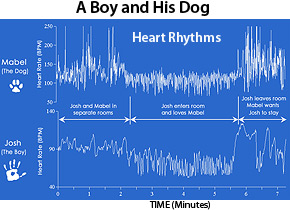An interesting excerpt from an article.

A Boy and His Dog
By now, many people are familiar with the HeartMath Institute’s widely publicized research showing heart-brain interactions between persons in close proximity: couples sleeping; a mother and her infant; individuals in coherent states.
The institute also has found that a type of heart-rhythm entrainment, or synchronization, can occur in interactions between people and their pets. A lot of pet lovers surely will appreciate the results of an experiment HMI Director of Research Dr. Rollin McCraty conducted with his 15-year-old son. McCraty did the experiment with son Josh and the boy’s dog, Mabel, at the HMI Research Center in Boulder Creek, Calif., using electrocardiogram monitors to record heart-rhythm data when the pair were together and apart.
“Here we used two Holter (electrocardiogram) recorders, one fitted on Mabel and the other on Josh,” McCraty wrote in his paper, The Energetic Heart: Bioelectromagnetic Interactions Within and Between People. “We synchronized the recorders and placed Mabel in one of our labs.”
Next, McCraty wrote, “Josh then entered the room and sat down and proceeded to consciously feel feelings of love towards Mabel. … When Josh entered the room where Mabel was waiting and consciously felt feelings of love and care towards his pet, his heart rhythms became more coherent, and this change appears to have influenced Mabel’s heart rhythms, which then also became more coherent.”
If you’ve ever wondered what goes on in your dog’s mind, or heart, when you leave home, this may help: “When Josh left the room, Mabel’s heart rhythms became much more chaotic and incoherent, suggesting initial separation anxiety,” McCraty wrote in the paper, which is now a HeartMath scientific monograph.

The top of the graph shows the dog’s (Mabel) shift when the boy (Josh, shown in the lower part of the graph) used the Heart Lock-In Technique to shift into coherence. There was no physical contact between the dog and boy.
Regarding these connections from person to person and between people and pets, McCraty later wrote, “Although more research in this area is still to be done, I do feel that we can affect our immediate environment.
It appears that there is a type of communication occurring between people above and beyond body language or verbal communication. I believe we’ll see in future research studies that we are affecting each other’s moods and attitudes, both positively and negatively by the electromagnetic fields we radiate.”
“In our work with pets and their owners, we’re seeing that a pet owner can create what we call a heart-filled environment when practicing heart-focused techniques (a cornerstone of HeartMath tools and technology). The pets respond by becoming more affectionate, more animated and more connected with the pet owner.”